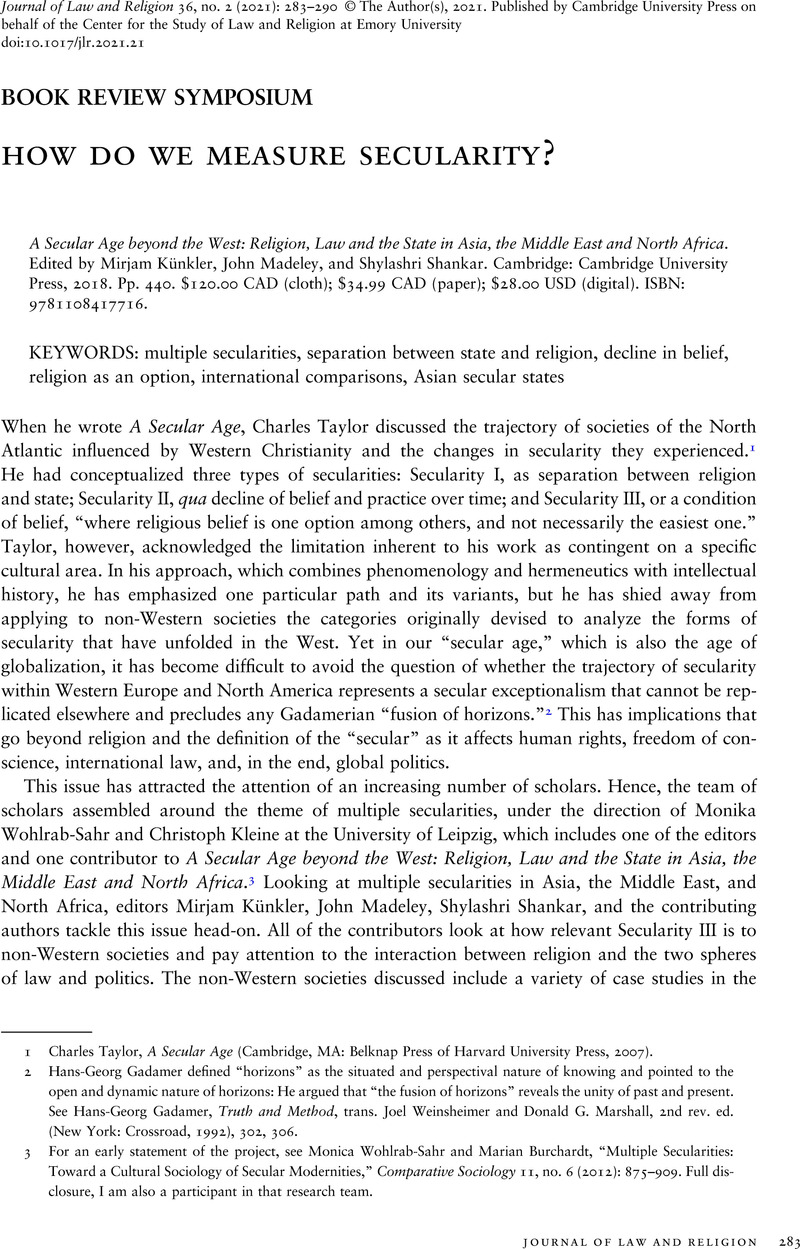No CrossRef data available.
Article contents
HOW DO WE MEASURE SECULARITY? - A Secular Age beyond the West: Religion, Law and the State in Asia, the Middle East and North Africa. Edited by Mirjam Künkler, John Madeley, and Shylashri Shankar. Cambridge: Cambridge University Press, 2018. Pp. 440. $120.00 CAD (cloth); $34.99 CAD (paper); $28.00 USD (digital). ISBN: 9781108417716.
Published online by Cambridge University Press: 25 June 2021
Abstract

Keywords
- Type
- Book Review Symposium: A Secular Age Beyond the West
- Information
- Copyright
- Copyright © The Author(s), 2021. Published by Cambridge University Press on behalf of the Center for the Study of Law and Religion at Emory University
References
1 Taylor, Charles, A Secular Age (Cambridge, MA: Belknap Press of Harvard University Press, 2007)CrossRefGoogle Scholar.
2 Hans-Georg Gadamer defined “horizons” as the situated and perspectival nature of knowing and pointed to the open and dynamic nature of horizons: He argued that “the fusion of horizons” reveals the unity of past and present. See Hans-Georg Gadamer, Truth and Method, trans. Joel Weinsheimer and Donald G. Marshall, 2nd rev. ed. (New York: Crossroad, 1992), 302, 306.
3 For an early statement of the project, see Wohlrab-Sahr, Monica and Burchardt, Marian, “Multiple Secularities: Toward a Cultural Sociology of Secular Modernities,” Comparative Sociology 11, no. 6 (2012): 875–909CrossRefGoogle Scholar. Full disclosure, I am also a participant in that research team.
4 Bhargava, Rajeev, “Reimagining Secularism: Respect, Domination and Principled Distance,” Economic and Political Weekly 48, no. 50 (2013): 79–92Google Scholar.
5 For earlier statements about this intermingling between religion and state in China, see the contributions to Ashiwa Yoshiko and David L. Wank, eds., Making Religion, Making the State: The Politics of Religion in Modern China (Stanford: Stanford University Press, 2009).
6 Ji has presented that argument in detail in a special issue devoted to the issue of education in East Asian societies: Ji Zhe, “Introduction: le jiao recomposé. L'éducation entre religion et politique dans la modernité chinoise” [Introduction: Rethinking jiao. Education between religion and politics in Chinese modernity], Extrême-Orient Extrême Occident, no. 33 (2011): 5–34.
7 There are very few cases of comparative historical studies that cover the four East Asian societies. A good attempt is offered by the contributions to Arnaud Brotons, Yannick Bruneton, and Nathalie Kouamé, eds., État, religion et répression en Asie: Chine, Corée, Japon, Vietnam (XIIIe–XXIe siècles) [State, religion and repression in Asia: China, Korea, Japan, Vietnam (13th–21st centuries)] (Paris: Karthala, 2011).
8 For an extended example of that debate, see the contributions to Rajeev Bhargava, ed., Secularism and Its Critics (New York: Oxford University Press, 2005), by T. A. Madan, Ashis Nandy, and Charles Taylor.
9 On Indonesia's secularity, see also Muchamad Ali Safa'at, “Indonesian Secularities: On the Influence of the State-Islam Relationship on Legal and Political Developments,” Working Paper Series of the HCAS “Multiple Secularities—Beyond the West, Beyond Modernities” 13, Leipzig University, Leipzig, 2019, https://doi.org/10.36730/2020.1.msbwbm.13.
10 For a good example of efforts to put the study of religion in China in a broader comparative context, see Fenggang, Yang, “The Red, Black and Gray Markets of Religion in China,” Sociological Quarterly 47, no. 1 (2006): 93–122Google Scholar. His theory has been criticized as too Christian-centric by scholars of Chinese religions in sociology, anthropology, and history. For a convincing account of Chinese religions that considers Chinese and non-Chinese scholarship and puts that in a broader context, see Vincent Goossaert and David Palmer, The Religious Question in Modern China (Chicago: University of Chicago Press, 2011).
11 Grim, Brian J. and Finke, Roger, “International Religion Indexes: Government Regulations, Government Favoritism, and Social Regulation of Religion,” Interdisciplinary Journal of Research on Religion 2, no. 1 (2006): 1–40Google Scholar.
12 That index itself is coming from the Religion and State dataset compiled and analyzed at length in Jonathan Fox, A World Survey of Religion and State (New York: Cambridge University Press, 2008).
13 John Lagerwey, China: A Religious State (Hong Kong: University of Hong Kong Press, 2010).
14 Zhang Yinghua, Taiwan diqu shehui bianqian jiben diaocha jihua. Diwuqi. Diwuci diaocha jihua zhixing baogao. [Fifth basic plan to survey social change in the Taiwan area: Report on the fifth survey] (Nangang: Zhongyuang yanjiuyuan shehuixue yanjiusuo, 2000).
15 Ellis, Stephen and Haar, Gerrie ter, “Religion and Politics in Sub-Saharan Africa,” Journal of Modern African Studies 36, no. 2 (1998): 175–201CrossRefGoogle Scholar.
16 For a good treatment on redemptive societies, or religious movements with a strong emphasis on morality see Duara, Prasenjit, Sovereignty and Authenticity: Manchukuo and the East Asian Modern (Lanham: Rowman and Littlefield, 2003)Google Scholar.
17 A key text on this issue is Kleine, Christoph, “Religion and the Secular in Premodern Japan from the Viewpoint of Systems Theory,” Journal of Religion in Japan 2, no. 1 (2013): 1–34CrossRefGoogle Scholar.



